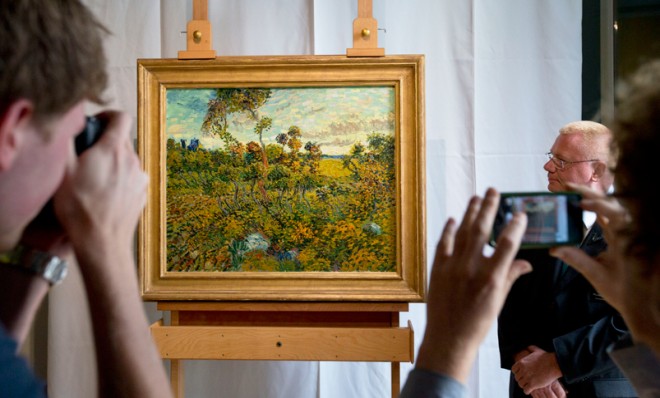How a Van Gogh painting stayed hidden for more than a century
A canvas potentially worth millions has spent much of its life in an attic


The Van Gogh Museum in Amsterdam unveiled a major new find on Monday: A newly authenticated, but long overlooked, painting by Vincent Van Gogh.
The work, "Sunset at Montmajour," was painted at the pinnacle of Van Gogh's career, in the late 1880s during his time in the southern French town of Arles, where he also painted masterpieces such as "The Sunflowers," The Yellow House," and "The Bedroom."
The Van Gogh Museum says its experts can even pinpoint the day Van Gogh completed it — July 4, 1888 — because he mentioned it in a letter he wrote to his brother Theo the next day.
The Week
Escape your echo chamber. Get the facts behind the news, plus analysis from multiple perspectives.

Sign up for The Week's Free Newsletters
From our morning news briefing to a weekly Good News Newsletter, get the best of The Week delivered directly to your inbox.
From our morning news briefing to a weekly Good News Newsletter, get the best of The Week delivered directly to your inbox.
The note was far from the only evidence indicating that it is the real deal, according to Van Gogh Museum Director Axel Ruger. The work also was painted on the same type of canvas as at least one other Van Gogh from the same period — "The Rocks" — with the same type of underpainting.
The location is clearly a landscape near Arles, showing Montmajour hill with the ruins of an abbey of the same name in the background. The pigments match paint Van Gogh used on other works he did in Arles.
"Sunset at Montmajour" also was listed as part of Theo Van Gogh's family art collection in 1890, the year his brother died.
With all this evidence, how did such an important painting disappear from view for more than a century?
A free daily email with the biggest news stories of the day – and the best features from TheWeek.com
Its slide into obscurity began in 1901, when it was exhibited in Paris and sold to Maurice Fabre, an art dealer there.
Van Gogh had confessed in his letter to his brother that "Sunset at Montmajour" was "well below what I'd wished to do." Apparently, at least one important art aficionado a century ago took a similarly dim view of the 37-inch-by-29-inch painting.
Fabre apparently sold the work to a Norwegian industrialist named Christian Nicolai Mustad in 1908 — although Fabre never recorded the sale — and it resurfaced as part of Mustad's estate in 1970. Mustad's family said he had banished it to his attic out of embarrassment after the French ambassador to Sweden told him the painting was a fake.
Even after Mustad's death, doubts lingered. The art dealer Daniel Wildenstein also branded the work a fake, or simply the work of a lesser-known artist. It was sold, quietly, to a collector. The Van Gogh Museum itself even turned down an opportunity to authenticate it in 1991.
Why was everyone fooled? One of the three experts who are calling the painting a real Van Gogh says it was simply a transitional moment in Van Gogh's style, so there are striking differences between what he did before, and after.
"From then on, Van Gogh increasingly felt the need to paint with more and more impasto and more and more layers," the expert, Teio Meedendorp, tells The Associated Press, referencing the artist's famously thick brush strokes.
Harold Maass is a contributing editor at The Week. He has been writing for The Week since the 2001 debut of the U.S. print edition and served as editor of TheWeek.com when it launched in 2008. Harold started his career as a newspaper reporter in South Florida and Haiti. He has previously worked for a variety of news outlets, including The Miami Herald, ABC News and Fox News, and for several years wrote a daily roundup of financial news for The Week and Yahoo Finance.
-
 Political cartoons for December 7
Political cartoons for December 7Cartoons Sunday’s political cartoons include the Trump-tanic, AI Santa, and the search for a moderate Republican
-
 Trump’s poll collapse: can he stop the slide?
Trump’s poll collapse: can he stop the slide?Talking Point President who promised to ease cost-of-living has found that US economic woes can’t be solved ‘via executive fiat’
-
 Codeword: December 7, 2025
Codeword: December 7, 2025The daily codeword puzzle from The Week
